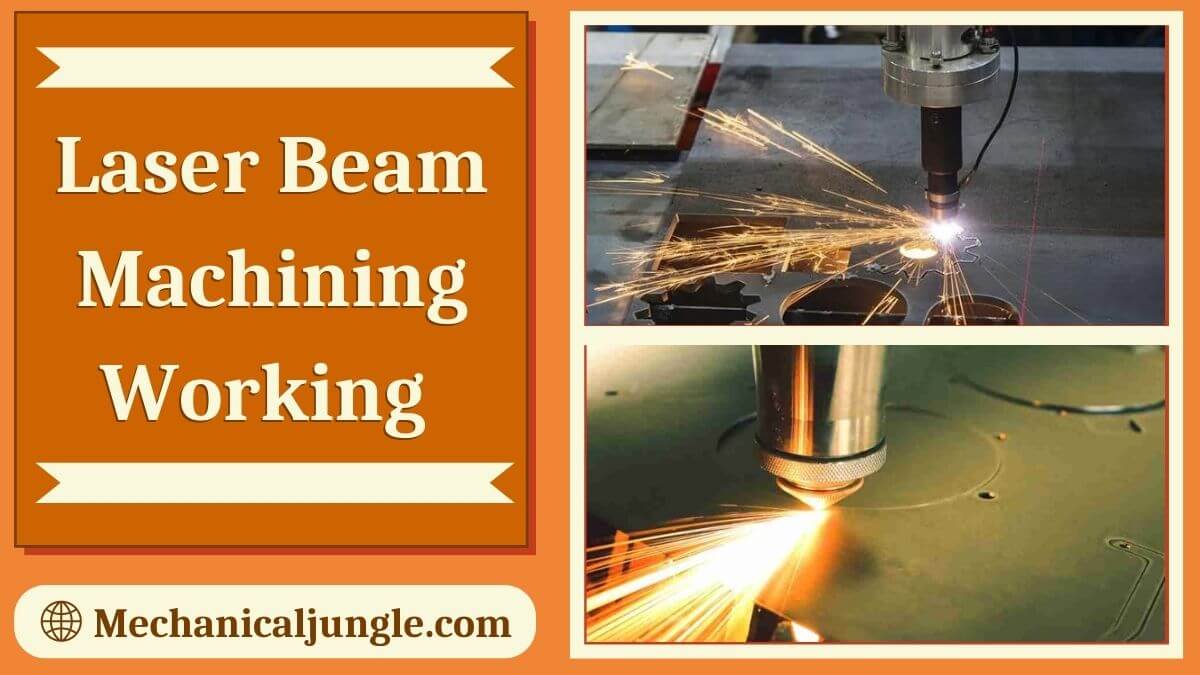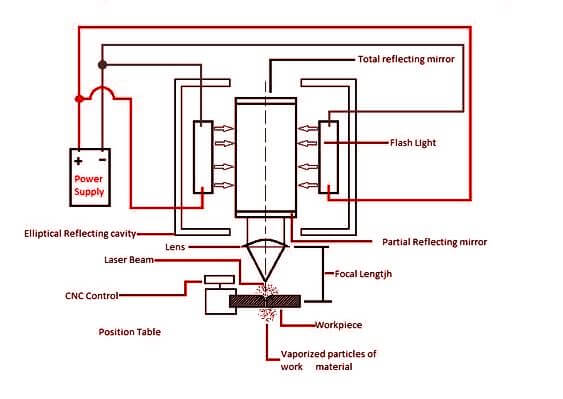
What Is Laser Beam Machining?

- A laser beam machining is a non-traditional machining method in which the operation is performed by laser light.
- The laser light has a maximum temperature on the workpiece, causing the workpiece to melt due to the high speed.
- The process used thermal energy to remove material from a metal surface.
- Laser beam machining is a form of the machining process in which laser beams are used for the Machinings of metal and non-metallic materials.
- In this process, laser beams of high energy are created to strike the workpiece, and the thermal energy of the lasers is transferred to the surface of the W/P (workpiece).
- The heat generated on the surface heats melts and vaporizes the material by w / p.Light amplification by stimulated emission of radiation called Laser.
Working Principle of Laser Beam Machining:
- A very high-energy laser beam is produced by laser machines.
- Focuses on the workpiece to mechanize this laser beam produced.
- When the laser beam hits the surfaces of the W/P, the thermal energy of the laser beam is transferred to the surfaces of the W/P.
- It heats, melts, evaporates, and eventually makes the material a workpiece.
- This is how laser beam machining works.
- It works on the principle that when a high-energy laser beam strikes the surfaces of the workpiece.
- The heat energy contained by the laser beams is transferred to the surface of the w/p.
- This heat energy absorbed by surface heat melts and evaporates the material w/p. Machining of materials in this way is done using laser beams.
Advantages of Laser Beam Machining:

- The Following Advantages of Laser Beam Machining Are:
- It can be focused on very small diameters. It produces a huge amount of energy, about 100 MW per square mm area.
- It is capable of producing a very accurately placed hole.
- Laser beam machinings have the ability to cut or engrave almost all types of materials when conventional machining processes fail to cut or engrave any material.
- There is no physical contact between the equipment and the workpiece.
- The wear and tear in this machinings process are very low and therefore requires a low maintenance cost. This machining process produces an object of very high precision.
- And most items do not require additional finishing; They can be combined with gases that help make the cutting process more efficient.
- This helps reduce oxidation of the W / P surface and keep it free of melting of the vaporized material.
- It has the ability to engraves or cut almost all types of material. But it is best suited for brittle materials with low conductivity.
Disadvantages of Laser Beam Machining:
- High initial cost. This is because it requires many accessories that are important to the machining process by Laser.
- Laser beam machining requires a highly trained worker to operate the machine.
- Low production rate because it is not designed for mass production.
- The machining process requires a lot of energy. It is not easy to produce deeps cuts with w / p that have high melting points and usually cause a cone.
Application of Laser Beam Machining:
- Laser beam machining is mostly used in the automobile, aerospace, shipbuilding, electronics, steel, and medical industries for precision machining complex parts.
- In heavy manufacturing industries, it is used or used for drillings and claddings, seam and spot weldings, among others.
- In light manufacturing industries, it is used for engravings and drilling other metals.
- In the electronics industry, it is used for circuiting and wire stripping (for connecting the two ends).
- In the medical industry, it is used for hair removal and cosmetic surgery.
Frequently asked questions (FAQs) that could be included in your article on laser beam machining:
What is laser beam machining (LBM)?
Laser beam machining is a non-traditional machining process where material removal is achieved using a highly focused laser beam. This beam of coherent light melts or vaporizes material from the workpiece surface.
How does laser beam machining work?
Laser beam machining works by directing a high-energy laser beam onto the workpiece surface. The intense heat generated by the laser beam melts or vaporizes the material, allowing precise cutting, drilling, or engraving without physical contact.
What are the advantages of laser beam machining?
Laser beam machining offers several advantages, including high precision, minimal material waste, the ability to work with a wide range of materials (including those difficult to machine with conventional methods), and the capability for complex geometries without additional finishing.
What materials can be processed using laser beam machining?
Laser beam machining can process a variety of materials, including metals (such as steel, aluminum), ceramics, plastics, and composites. It is particularly effective for brittle materials and those with low thermal conductivity.
What are the main applications of laser beam machining?
Laser beam machining is used extensively in industries such as automotive, aerospace, electronics, medical, and manufacturing. Common applications include cutting, welding, engraving, drilling, and surface treatment.
What are the disadvantages of laser beam machining?
Some disadvantages include high initial equipment cost, the need for skilled operators, limited production rates compared to conventional methods, and challenges with deep cuts in high-melting-point materials.
How does laser beam machining compare to traditional machining methods?
Unlike traditional machining methods that rely on mechanical tools, laser beam machining is non-contact and uses thermal energy for material removal. It often results in higher precision and can achieve intricate designs that may be challenging with traditional tools.
What considerations are important for implementing laser beam machining?
Factors such as laser power, beam quality, focusing optics, and control systems play crucial roles in optimizing laser beam machining processes. Proper safety measures and maintenance of equipment are also essential.
What future trends are emerging in laser beam machining technology?
Advances in laser technology are focusing on improving efficiency, reducing operating costs, enhancing automation, and expanding the range of materials that can be effectively processed. Integration with digital control systems and robotics is also becoming more prevalent.
How environmentally friendly is laser beam machining?
Laser beam machining can be considered more environmentally friendly than some traditional machining methods due to reduced material waste and energy-efficient operation. However, proper handling of laser emissions and waste disposal are still important considerations.

